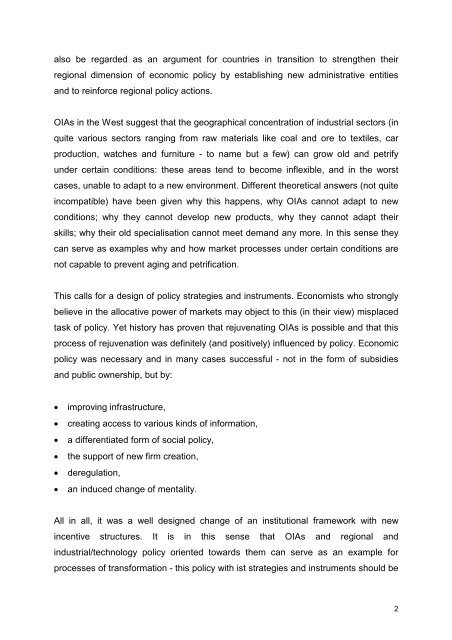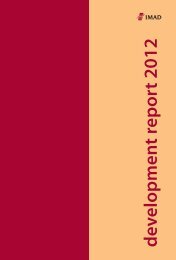Institutional Change in Old Industrial Areas – Lessons for ... - UMAR
Institutional Change in Old Industrial Areas – Lessons for ... - UMAR
Institutional Change in Old Industrial Areas – Lessons for ... - UMAR
You also want an ePaper? Increase the reach of your titles
YUMPU automatically turns print PDFs into web optimized ePapers that Google loves.
also be regarded as an argument <strong>for</strong> countries <strong>in</strong> transition to strengthen their<br />
regional dimension of economic policy by establish<strong>in</strong>g new adm<strong>in</strong>istrative entities<br />
and to re<strong>in</strong><strong>for</strong>ce regional policy actions.<br />
OIAs <strong>in</strong> the West suggest that the geographical concentration of <strong>in</strong>dustrial sectors (<strong>in</strong><br />
quite various sectors rang<strong>in</strong>g from raw materials like coal and ore to textiles, car<br />
production, watches and furniture - to name but a few) can grow old and petrify<br />
under certa<strong>in</strong> conditions: these areas tend to become <strong>in</strong>flexible, and <strong>in</strong> the worst<br />
cases, unable to adapt to a new environment. Different theoretical answers (not quite<br />
<strong>in</strong>compatible) have been given why this happens, why OIAs cannot adapt to new<br />
conditions; why they cannot develop new products, why they cannot adapt their<br />
skills; why their old specialisation cannot meet demand any more. In this sense they<br />
can serve as examples why and how market processes under certa<strong>in</strong> conditions are<br />
not capable to prevent ag<strong>in</strong>g and petrification.<br />
This calls <strong>for</strong> a design of policy strategies and <strong>in</strong>struments. Economists who strongly<br />
believe <strong>in</strong> the allocative power of markets may object to this (<strong>in</strong> their view) misplaced<br />
task of policy. Yet history has proven that rejuvenat<strong>in</strong>g OIAs is possible and that this<br />
process of rejuvenation was def<strong>in</strong>itely (and positively) <strong>in</strong>fluenced by policy. Economic<br />
policy was necessary and <strong>in</strong> many cases successful - not <strong>in</strong> the <strong>for</strong>m of subsidies<br />
and public ownership, but by:<br />
• improv<strong>in</strong>g <strong>in</strong>frastructure,<br />
• creat<strong>in</strong>g access to various k<strong>in</strong>ds of <strong>in</strong><strong>for</strong>mation,<br />
• a differentiated <strong>for</strong>m of social policy,<br />
• the support of new firm creation,<br />
• deregulation,<br />
• an <strong>in</strong>duced change of mentality.<br />
All <strong>in</strong> all, it was a well designed change of an <strong>in</strong>stitutional framework with new<br />
<strong>in</strong>centive structures. It is <strong>in</strong> this sense that OIAs and regional and<br />
<strong>in</strong>dustrial/technology policy oriented towards them can serve as an example <strong>for</strong><br />
processes of trans<strong>for</strong>mation - this policy with ist strategies and <strong>in</strong>struments should be<br />
2
















